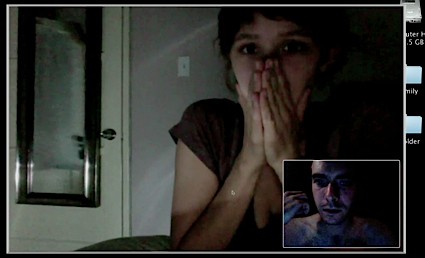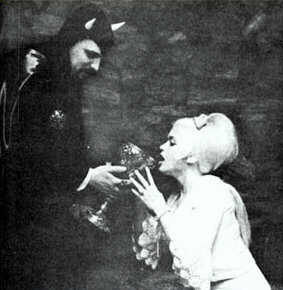In anticipation of Mother’s Day, I’ve decided to write about a trope in horror fiction that is a dark meditation on maternity: the Demon Child. This trope tends to divide itself into two separate categories: firstly, the demonic unborn child or baby; and second, the older but equally demonic child. While these two subcategories are closely related, there are subtle but critical differences between them that influence our reading of these character types and the meaning behind them. This post shall focus on the unborn Demon Child, a character type that TVTropes — in their usual tongue-in-cheek manner — dub the Fetus Terrible:
…The Fetus Terrible hasn’t even been born yet, but will become The Antichrist or a demon prophesied to bring about The End of the World as We Know It once it escapes from its womb. The woman carrying this (often literally) hellborn spawn is usually an innocent, unwittingly impregnated by the Devil himself, and the other characters have to race to prevent the birth or stop the child from becoming the ultimate Enfant Terrible. Occasionally this can result of a perfectly normal pregnancy Gone Horribly Wrong pre or post conception, where the issue can be a mutant, Hybrid Monster, Undead Child or some other abomination. This trope can also overlap with Body Horror, especially if the mother knows what’s growing inside her — TVTropes.org
In its fetal state, the Demon Baby represents maternal anxiety over the physicality of pregnancy and childbirth. Pregnancy itself is an invasive process not unlike parasitism, whereby a separate and distinct life form develops and thrives within a host’s body. As suggested in the above quote from TVTropes, the Demon Baby possesses aspects of body horror — a branch of the horror universe that explores fear relating to a loss-of-control over one’s own body. Not only does the mother-to-be fear the creature that grows inside her, there is often the threat of a grisly, and deadly, childbirth that capitalizes on every woman’s fear of painful labour and maternal mortality. While Roman Polanski’s 1968 film Rosemary’s Baby practically invented this horror trope, the scene I feel best encapsulates this element of demon baby/body horror is the birthing scene from a much lesser film, the Hammer production To the Devil a Daughter (1976) with Christopher Lee and Nastassja Kinski. When the child of Satan is ready to be born, it demands the ultimate maternal sacrifice as it literally bursts forth from the womb, tearing the hapless woman apart. Although the actual birth happens off-camera, the mere suggestion of this gruesome event was enough to make me shudder.

The unfortunate Margaret is ripped apart birthing the demon child in “To the Devil A Daughter” (1976). Ew.
And then, there’s the Demon Baby — or should I say, Demon Puppet? In this late-70’s, low-budget film, the devil-spawn is a slimy, malformed little puppet that — in one nightmarish dream sequence — flops across the splayed legs of the adolescent Kinski and crawls back inside. Yeah, back up there. I know, right?
Oh, and Happy Mother’s Day.











